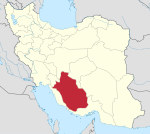Naqsh-e Rajab
29°57′59″N 52°53′13″E / 29.966486°N 52.887043°E

Naqsh-e Rajab (Persian: نقش رجب, Persian pronunciation: [næɣʃeɾæˈd͡ʒæb]) is an archaeological site just east of Istakhr and about 12 km north of Persepolis in Fars Province, Iran.
Together with Naqsh-e Rustam, which lies less than a kilometer away, the site is part of the Marvdasht cultural complex. Together, the two sites are a tentative candidate for UNESCO World Heritage status.[1]
Naqsh-e Rajab is the site of four limestone rockface inscriptions and rock-cut bas-reliefs that date to the early Sassanid era. One of the carvings is the investiture inscription of Ardeshir I (ruled in 226-241 CE), the founder of the dynasty. The second investiture inscription is Ardeshir's successor, Shapur I (241-272 CE). A third bas-relief, known as 'Shapur's Parade' celebrates the king's military victory in 244 over the Roman emperor Valerian and Philip the Arab. A fourth bas-relief and inscription is attributed to Kartir, high priest under Shapur I and his sons Hormizd I (272-273 CE) and Bahram I (273–276 CE).
See also
- List of colossal sculpture in situ
- Naqsh-e Rustam
- Taq-e Bostan, another site of Sassanid-era rock reliefs.
References
- ^ "Nasqsh-e Rostam and Naqsh-e Rajab". UNESCO World Heritage Centre.
External links
![]() Media related to Naqsh-e Rajab at Wikimedia Commons
Media related to Naqsh-e Rajab at Wikimedia Commons
- Marvdasht complex
- Sasanian architecture
- Sculpture of the Ancient Near East
- Buildings and structures in Fars Province
- Visitor attractions in Fars Province
- Outdoor sculptures in Iran
- Rock reliefs
- Ancient Near East stubs
- Marvdasht County geography stubs
- Iranian building and structure stubs
- Near East archaeology stubs

